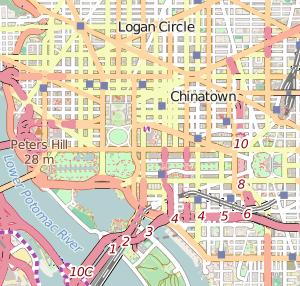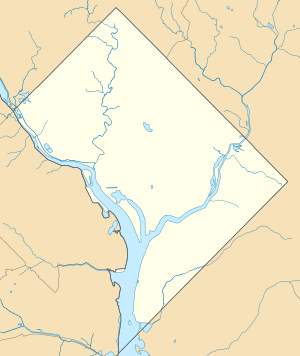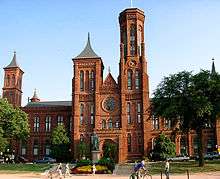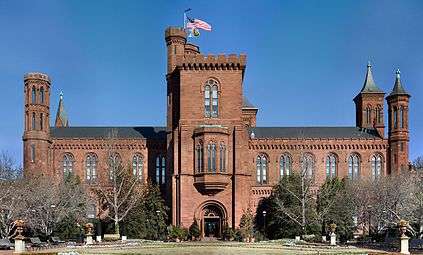Smithsonian Institution Building
- For similar uses and terms, see Smithsonian (disambiguation).
|
Smithsonian Institution Building | |
|
The Castle | |
   | |
| Location | Washington, D.C. |
|---|---|
| Coordinates | 38°53′19.49″N 77°1′33.59″W / 38.8887472°N 77.0259972°WCoordinates: 38°53′19.49″N 77°1′33.59″W / 38.8887472°N 77.0259972°W |
| Built | 1849- 1855 |
| Architect | James Renwick, Jr. |
| NRHP Reference # | 66000867 |
| Significant dates | |
| Added to NRHP | October 15, 1966[1] |
| Designated NHL | January 12, 1965[2] |
The Smithsonian Institution Building, located near the National Mall in Washington, D.C. behind the National Museum of African Art and the Sackler Gallery, houses the Smithsonian Institution's administrative offices and information center. The building is constructed of Seneca red sandstone in the faux Norman style (a 12th-century combination of late Romanesque and early Gothic motifs; built in the Gothic and Romanesque revival styles) and is nicknamed The Castle. It was designated a National Historic Landmark in 1965.[2]
History
The Castle was the first Smithsonian building, designed by architect James Renwick, Jr., whose other works include St. Patrick's Cathedral in New York City and the Smithsonian's Renwick Gallery, also in Washington D.C. The building committee held a nationwide design competition in 1846 and selected Renwick's design by a unanimous vote. A cardboard model of Renwick's winning design survives and is on display in the Castle. Renwick was assisted by Robert Mills,[3] particularly in the internal arrangement of the building.[4]

Initially intended to be built in white marble, then in yellow sandstone,[4] the architect and building committee finally settled on Seneca red sandstone from the Seneca Quarry in Montgomery County, Maryland. The redstone was substantially less expensive than granite or marble, and while initially easy to work, was found to harden to a satisfactory degree on exposure to the elements.[5] Scholarly evidence indicates it is likely that slaves were employed at Seneca in quarrying stone for the Castle, though no evidence has surfaced that slaves were involved in the actual Castle construction.[6]
The building committee selected Gilbert Cameron as the general contractor, and construction began in 1847. The East Wing was completed in 1849 and occupied by Secretary Joseph Henry and his family. The West Wing was completed later the same year. A structural collapse in 1850 of partly completed work raised questions of workmanship and resulted in a change to fireproof construction. The Castle's exterior was completed in 1852; Renwick's work was completed and he withdrew from further participation. Cameron continued the interior work, which he completed in 1855.[3]
Despite the upgraded fireproof construction, a fire in 1865 caused extensive damage to the upper floor of the building, destroying the correspondence of James Smithson, Henry's papers, two hundred oil paintings of American Indians by John Mix Stanley, the Regent's Room and the lecture hall, and the contents of the public libraries of Alexandria, Virginia and Beaufort, South Carolina, confiscated by Union forces during the American Civil War. The ensuing renovation was undertaken by local Washington architect Adolf Cluss in 1865-67. Further fireproofing work ensued in 1883, also by Cluss, who by this time had designed the neighboring Arts and Industries Building. A third and fourth floor were added to the East Wing, and a third floor to the West Wing. Electric lighting was installed in 1895.[3]
Around 1900 the wooden floor of the Great Hall was replaced with terrazzo and a Children's Museum was installed near the south entrance. A tunnel connected to the Arts and Industries Building. A general renovation took place in 1968-70 to install modern electrical systems, elevators and heating, ventilation and air conditioning systems.[3] The Enid A. Haupt Garden was dedicated in 1987, along with the Renwick Gate facing Independence Avenue, built from Seneca redstone retrieved from the demolished D.C. Jail. [7]
Description
James Renwick designed the Castle as the focal point of a picturesque landscape on the Mall, using elements from Georg Moller's Denkmäler der deutschen Baukunst. Renwick originally intended to detail the building with entirely American sculptural flora in the manner of Benjamin Henry Latrobe's work at the United States Capitol, but the final work used conventional pattern-book designs.[4]
The building is completed in the Gothic Revival style with Romanesque motifs. This style was chosen to evoke the Collegiate Gothic in England and the ideas of knowledge and wisdom. The façade is built with red sandstone from the Seneca quarry in Seneca, Maryland in contrast to the granite, marble and yellow sandstone from the other major buildings in Washington, D.C.[5]

The building comprises a central section, two extensions or ranges, and two wings. Four towers contain occupiable space, while five smaller towers are primarily decorative, although some contain stairs. As constructed, the central section contained the main entry and museum space (now the Great Hall), with a basement beneath and a large lecture room above. Two galleries on the second floor were used to display artifacts and art. This area is now the Visitor’s Information and Associates’ Reception area. The East Range contained laboratory space on the first floor and research space on the second. The East Wing contained storage space on the first floor and a suite of rooms on the second as an apartment for the Secretary of the Smithsonian. This space is currently used as administrative offices and archives. The West Range was one story and used as a reading room. The West Wing, known as the chapel, was used as a library.[3] The West Wing and Range are now used as a quiet room for visitors to go.
On the exterior, the principal tower on the south side is 91 feet (28 m) high and 37 feet (11 m) square. On the north side there are two towers, the taller on 145 feet (44 m) tall. A campanile at the northeast corner is 17 feet (5.2 m) square and 117 feet (36 m) tall.[3]
The plan allowed for expansion at either end, a major reason for the informal medievally-inspired design, which would not suffer if asymmetrically developed.[4]
Current use
The Smithsonian Castle houses the administrative offices of the Smithsonian. The main Smithsonian visitor center is also located here, with interactive displays and maps. Computers electronically answer most common questions. A crypt just inside the north entrance houses the tomb of James Smithson.[8]
See also
- Seneca Quarry, the source of red sandstone for the Smithsonian Castle, listed on the National Register of Historic Places
Gallery


 Smithsonian Castle and Enid Haupt Garden - March 2016
Smithsonian Castle and Enid Haupt Garden - March 2016 A taxidermied snow leopard is exhibited inside the building.
A taxidermied snow leopard is exhibited inside the building. A taxidermied peacock on display
A taxidermied peacock on display Enid A. Haupt Garden
Enid A. Haupt Garden
References
- ↑ "National Register Information System". National Register of Historic Places. National Park Service. January 23, 2007.
- 1 2 "Smithsonian Institution Building". National Historic Landmark summary listing. National Park Service. Retrieved May 10, 2009.
- 1 2 3 4 5 6 Morton, W. Brown III (February 8, 1971). "National Register of Historic Places Inventory Nomination: Smithsonian Institution Building" (PDF). National Park Service. Retrieved May 11, 2009.
- 1 2 3 4 Scott, Pamela; Lee, Antoinette J. (1993). "The Mall". Buildings of the District of Columbia. New York: Oxford University Press. pp. 94–96. ISBN 0-19-509389-5.
- 1 2 Peck, Garrett (2013). The Smithsonian Castle and the Seneca Quarry. Charleston, SC: The History Press. pp. 42–56. ISBN 978-1609499297.
- ↑ Auslander, Mark (December 12, 2012). "Enslaved Labor and Building the Smithsonian: Reading the Stones". Southern Spaces.
- ↑ Peck, Garrett (2013). The Smithsonian Castle and the Seneca Quarry. Charleston, SC: The History Press. pp. 122–126. ISBN 978-1609499297.
- ↑ "Smithsonian Institution Building". Histories of the Smithsonian Institution's Museums and Research Centers. Smithsonian Institution. Retrieved May 11, 2009.
Further reading
- Auslander, Mark, "Enslaved Labor and Building the Smithsonian: Reading the Stones," Southern Spaces, December 12, 2012.
External links
 Media related to Smithsonian Institution Building at Wikimedia Commons
Media related to Smithsonian Institution Building at Wikimedia Commons Geographic data related to Smithsonian Institution Building at OpenStreetMap
Geographic data related to Smithsonian Institution Building at OpenStreetMap- Official website
- Historic American Buildings Survey (HABS) No. DC-141, "Smithsonian Institution Building, 1000 Jefferson Drive, between Ninth & Twelfth Stre, Washington, District of Columbia, DC", 128 photos, 4 color transparencies, 27 measured drawings, 7 data pages, 11 photo caption pages
- Smithsonian Institution Building, The Castle at Google Cultural Institute
